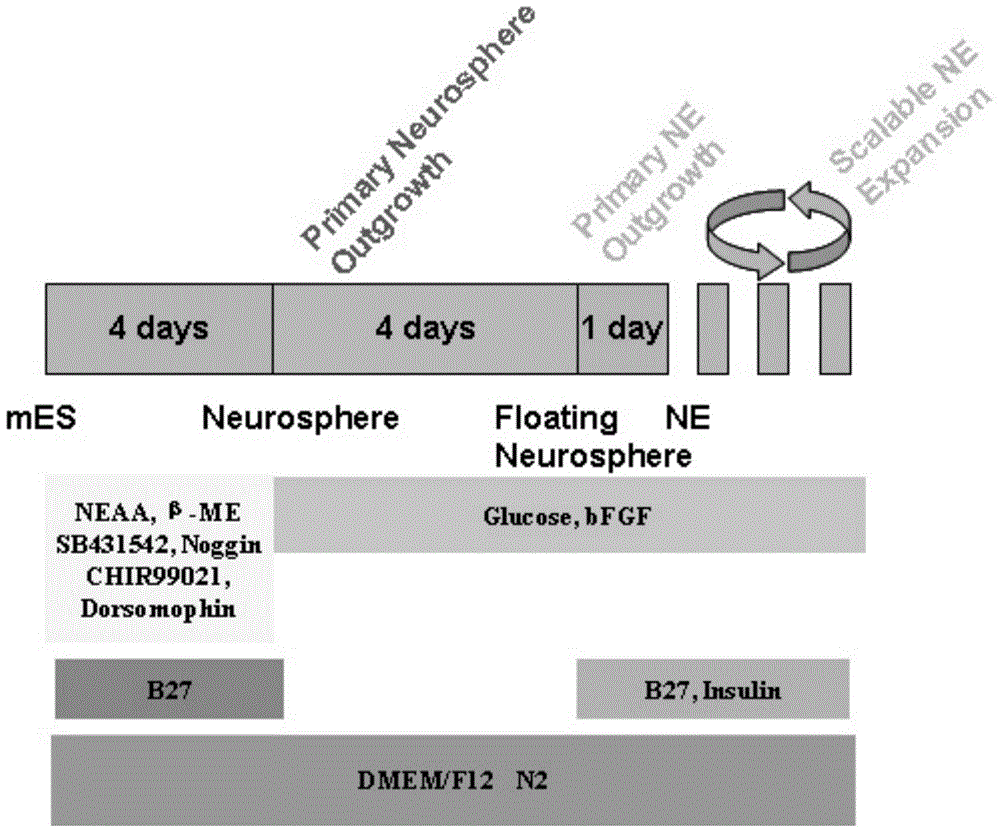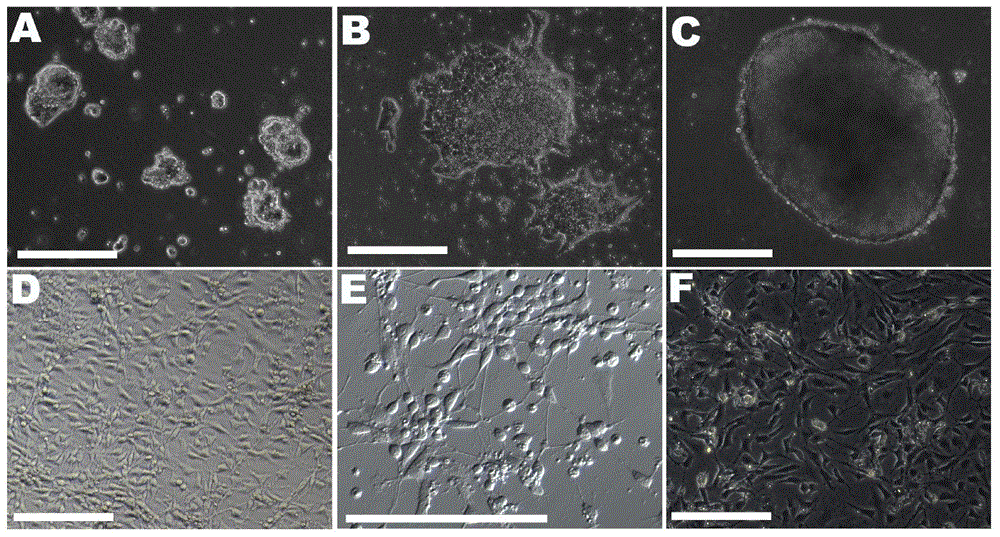A rapid and direct method for inducing the differentiation of mouse embryonic stem cells into neuroepithelial cells
A technology of neuroepithelial cells and embryonic stem cells, applied in animal cells, nervous system cells, vertebrate cells, etc.
- Summary
- Abstract
- Description
- Claims
- Application Information
AI Technical Summary
Problems solved by technology
Method used
Image
Examples
Embodiment 1
[0079] Example 1 Rapid and direct induction of mouse embryonic stem cells to differentiate into neuroepithelial cells
[0080] The purpose of the experiment: mouse embryonic stem cells differentiate into neuroepithelial cells with high efficiency and the generated neuroepithelial cells can carry out self-replication and long-term proliferation. Mouse embryonic stem cells (mESCs) were purchased from Shanghai Stance Biotechnology Co., Ltd., strain M1.
[0081] First, 24-well plates (Corning) were coated with Matrigel (BD). After cell counting, mouse embryonic stem cells (mESCs) were plated at 1x10 3 The number per well was seeded on a cell culture plate. Add 400 μl of culture medium to each well, and change the medium every other day. After 3-5 days, the cells grow into clump-like clones, and then start induction, which is divided into 3 stages.
[0082] 1) The first stage: the medium of the adherent cultured mouse embryonic stem cell cluster clones was replaced with the fir...
Embodiment 2
[0089] Example 2 Immunological identification of mouse neuroepithelial cells
[0090] The first to third generation of neuroepithelial cells obtained in Example 1 were subjected to immunofluorescence detection, and the specific steps included fixation, membrane rupture, and blocking solution for blocking for 1 hour, and then adding primary antibodies at the ratio of Nestin (Beyotime) 1:10 , Sox2 (CST) 1:200, Sox1 (R&D) 1:10, Pax6 (Abcam) 1:20, CD133 (Bioss) 1:100 or Sox9 (Millipore) 1:5000 overnight at 4°C, after washing with PBS, add a Anti-appropriate fluorescent secondary antibody FITC (ImmunoResearch), CY3 (ImmunoResearch) was incubated at room temperature for 2 hours. Finally, after washing with PBS, the cells were stained with Hoechst or DAPI and mounted with a mounting agent. Detection was performed under a fluorescence microscope (Zeiss) and a scanning laser confocal imaging system (Leica). Immunofluorescent staining of NE revealed expression of the neural progenitor...
Embodiment 3
[0091] Example 3 Identification of polar structure of neuroepithelial cells and neural rosette-shaped specific markers The neuroepithelial cells obtained in Example 1 were subjected to cell immunofluorescence staining, the operation method was the same as in Example 2, and the primary antibodies used were respectively PLZF (Santa Cruz) 1:50, ZO-1 (Santa Cruz) 1:50, SOX2 (CST) 1:200, PAX6 (Abcam) 1:200, the results show that the neuroepithelial cells obtained in Example 1 show nuclear expression transcription Factors PLZF and DACH1, and the expression of neuroepithelial polarity marker ZO-1 was also found (such as Figure 6 As shown, A. NE-specific transcription factor DACH1, also expresses neural precursor marker Nestin. B. NE can also be stained by the neural precursor transcription factor Sox2. C.NE can express the polarity marker ZO-1, indicating the polarity characteristics of neuroepithelial cells, and can also express the neural precursor marker Pax6. D.NE expresses it...
PUM
 Login to View More
Login to View More Abstract
Description
Claims
Application Information
 Login to View More
Login to View More - R&D
- Intellectual Property
- Life Sciences
- Materials
- Tech Scout
- Unparalleled Data Quality
- Higher Quality Content
- 60% Fewer Hallucinations
Browse by: Latest US Patents, China's latest patents, Technical Efficacy Thesaurus, Application Domain, Technology Topic, Popular Technical Reports.
© 2025 PatSnap. All rights reserved.Legal|Privacy policy|Modern Slavery Act Transparency Statement|Sitemap|About US| Contact US: help@patsnap.com



